How to Find, Monitor, and Beat Your Competition

Everyone wants to get ahead of their competition. But there’s far more to love about monitoring the competition than just the satisfaction of beating them in the search results.
In short, you can learn a lot from your competitors.
What they’re doing right. What they’re doing wrong. Or simply, what they’re doing.
And you can use all this information to your advantage, especially as a small business owner.
But first, you need to find out who your competitors are (or check that those you think you’re competing against, are actually your competition).
In this post, we’ll walk you through how to identify who your competitors are, the tools and tactics you can use to track them, and the opportunities for you to use that information to beat them.
- How to Identify Your Competitors
- The Tactics You Can Use to Monitor Your Competitors
- Tools to Track Your Competitors
Ready to take your website to the next level? Let’s dive in!
Search Engine Optimization Made Easy
We take the guesswork (and actual work) out of growing your website traffic with SEO.

How to Identify Your Competitors
Your obvious go-to is Google. Just search for your most important keywords, and see who’s ranking for them.
Bear in mind, however, that depending on the size of your brand and the Domain Authority of your site, those at the top of the search results aren’t necessarily your “realistic” competitors. You can still analyze them and learn from them, but your focus should be on companies you share a (more or less) level playing field with.
For that, you might have to step off the first page of Google’s search results. You might also have to look up some slightly less competitive search terms.
Businesses with a local presence have another thing to consider.
Your closest competitors are those that are not only close to you in terms of the products they offer but geographically, too.
Discovering them, thankfully, is easy. Just adapt your search terms to include the location (or locations) of your premises.
Other ways to uncover your competitors are included in some of the tools we’ll talk about below, so stick with us to learn about some of the best tools for finding and monitoring your competitors’ marketing activities.
But first, let’s talk about …
The Tactics You Can Use to Monitor Your Competition
Wondering how to monitor your competitors? And how you can get started with competitor analysis? We can help!
There are countless ways you can track your competitors and what they’re up to — for example, the strategies they’re employing, the keywords they’re targeting, and the results they’re getting.
Just looking at their site (specifically their title tags) should give you a good idea of the keywords they’re targeting. Tools like Semrush, Sistrix, and others listed below can be used to view some of the keywords they’re ranking for. You can also use the FATRANK Chrome extension to instantly discover where a site ranks for any given keyword.
In addition, you can look at their current links and monitor their sites for new links. Pay particular attention to industry-relevant links, and links to content they’ve created (you may well be able to target those links too.)
Another tactic for monitoring your competitors involves researching and analyzing their most shared content.
- Why’s this content getting shared?
- Who’s sharing it and where?
- And how can you create something similar (but better) to try and replicate their results?
Just simple things like checking in on their social activity, reading their blog content, monitoring their brand name with Google Alerts, and signing up (and paying attention to) their mailing list can give you valuable insights into your competitors’ tactics and the quality and strength of their marketing strategy.
Related: How to Create a Content Marketing Strategy
Tools to Track Your Competitors’ Ads
What Runs Where
What Runs Where is designed solely for competitive analysis of the paid ads market.
In short, it removes the guesswork and reduces the time you spend testing, so you can start pushing out more effective ads faster.
Sistrix
Sistrix covers most of what you need in a digital marketing tool. Included in that is a nifty little feature that brings up heaps of data for any site — perfect for sites you want to keep an eye on.
All you need to do is login and head to the More section. From there, you can click Ads and access the dashboard.

Next, populate the search bar at the top with the domain you want to look at, and you’ll be presented with all the data Sistrix has on that domain.
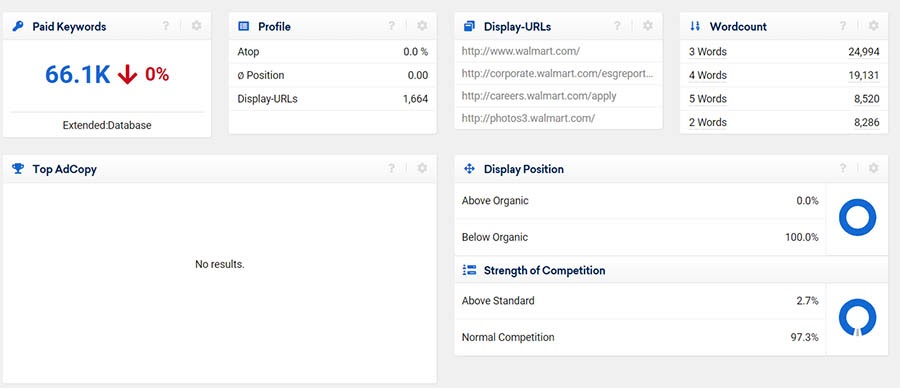
You can see:
- Their paid keywords
- Their profile
- Their display URLs
- The word count of their ads
- The display position
- The strength of the competition
- Their top ad copy
- The history of their paid keywords
- Their best keywords
You can even see and look at the banner ads they are using.
Handy, huh?

Semrush
Semrush has been in the digital marketing space for years, and if you want the most bang for your buck, it’s a good bet as your go-to SEO tool.
Their competitive research for ads kicks butt and is invaluable when it comes to spying on your competition.
Navigate to the Advertising Research section, and you’ll get a wealth of data, including:
- Number of keywords
- Estimated traffic for the competitor
- The estimated traffic cost
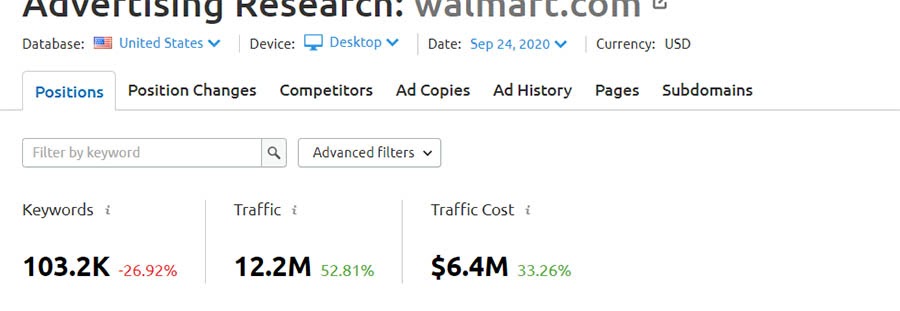
Changes over time can also be viewed in simple — but super helpful — graphs.


In addition to this, you can view position changes, competitors, ad copy, ad history, pages, and subdomains.
Pay special attention to the Competitors tab. It’s extremely useful.
For one, you’ll get a cool-looking competitive positions map.

You’ll also get a list of all potential competitors and their data. In the example below, we can see that Walmart has over 15,000 competitors in its ads market.
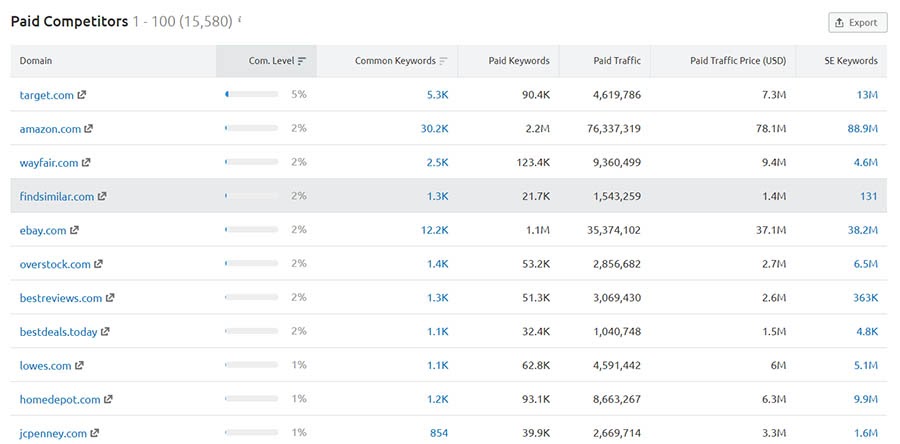
The amount of data you can collect on your competitors from Semrush is — in short — amazing. Trying to collate this data by hand would take weeks or months, but in Semrush, you can grab it with the click of a button.
If this sounds like something you’re interested in, we’ve worked out a free trial with Semrush for our readers, so you can see if the tool is a good fit for your site without a long-term commitment!
Spyfu
Founded in 2002 and originally called Googspy, Spyfu is one of the original players in the ad monitoring tool space.
While Spyfu has since evolved into a more complete marketing tool, its ad competitive intelligence alone makes it worth investing in.
To access it, head over to the PPC Research tab and enter the name of the domain you want to research.
From there, you get a nice clean dashboard that includes a lot of data. You’ll see:
- Monthly paid keywords
- Estimated monthly PPC clicks
- Estimated monthly PPC budget
- Overall market research
- How long Spyfu has been collecting the domain’s ads
- Buy recommendations
- Worst performing keywords
This can also be exported to a handy PDF.
If you want more, click on the Competitors tab in the main menu. Spyfu will then pull the data for the sites it believes are competing for ads for that domain.
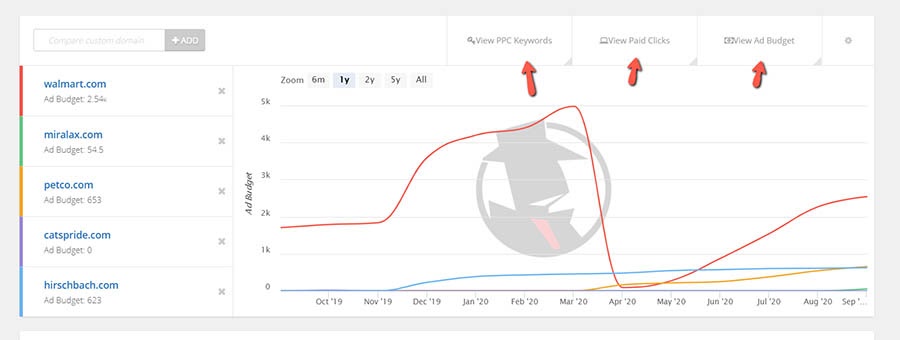
If you believe Spyfu’s picked the wrong competitors or you have a particular competitor in mind, you can add a custom domain.
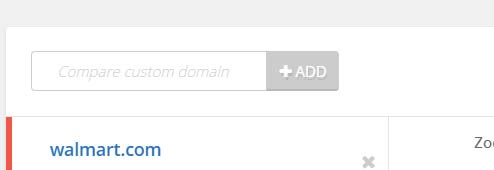
The tool also lets you graph PPC keywords, paid clicks, and ad budgets over time. Handy.
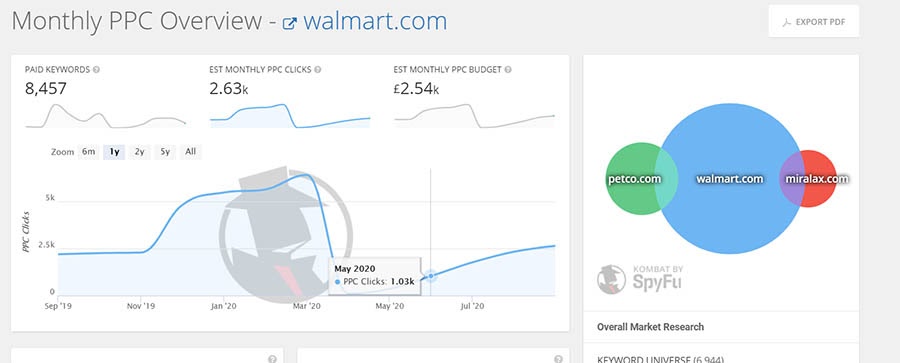
Another powerful feature in Spyfu is Kombat.
The name might sound a bit intimidating, but don’t let that put you off. It essentially lets you compare the keyword universe of three domains to see which ads are competing and which ads are exclusive to a particular competitor.
This will help you spot where your competitors are outdoing you because you don’t currently have ads in those areas.
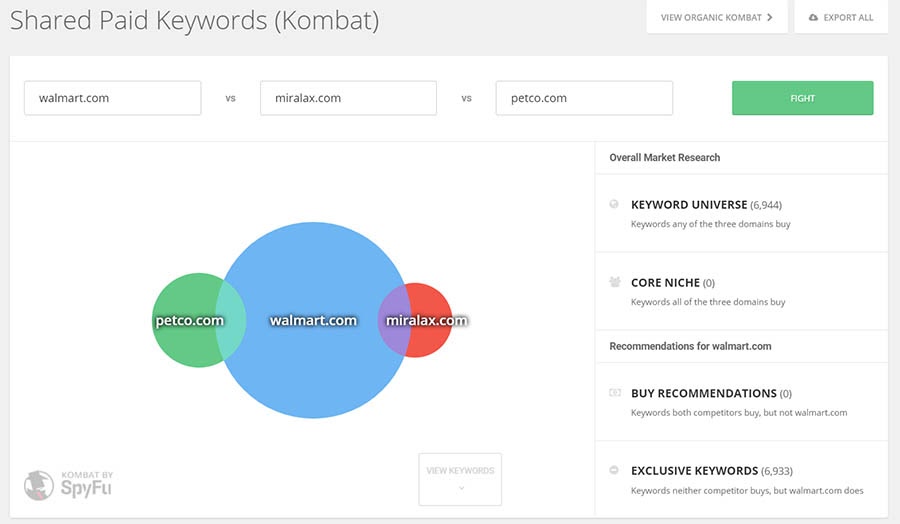
Beyond this, Spyfu can help you supercharge your PPC research and account with other features like Keyword Groups, PPC keywords, Ad History, Ad Advisor, and Adwords Templates.
Related: The Top SEO Tools to Optimize Your Website for Success
Backlinks
If you’ve been working in Digital Marketing for a few weeks or even a few days, you likely understand the importance of links. They’re pretty much the heart of SEO and still today remain one of the biggest ranking factors.
Related: How to Create a Link Building Strategy
But how do you find out who’s linking to you, and more specifically, who’s linking to your competitors?
Here are a few tools to help.
Ahrefs
Ahrefs was a bit of a latecomer to the backlink research tool market, but it quickly established itself as one of the big players thanks to its massive index of links and ultra-smooth interface.
Once logged in, head over to the Site Explorer section.
From there, just pop in your own domain or the domain of a competitor.

Ahrefs will start doing its magic and pull in data points for the domain, including:
- Ahrefs rank
- Number of backlinks
- Number of referring domains
- The number of keywords it ranks for
- Organic traffic
- Traffic value
- Crawled pages
- A breakdown of the kind of sites linking to the page
- Referring pages, IPs, and subnets
- New and lost referring domains
- New and lost backlinks
- The distribution of links by country
- How the links are distributed across Ahrefs URL rating
That’s a whole lot of data!
Everything is exportable to Excel, so you can easily chop and change the data and focus specifically on what you want to dig into.
One of Ahrefs’ best features for competitor research is their Link Intersection Tool.
Simply add in your own website and a handful of your competitors’ sites.
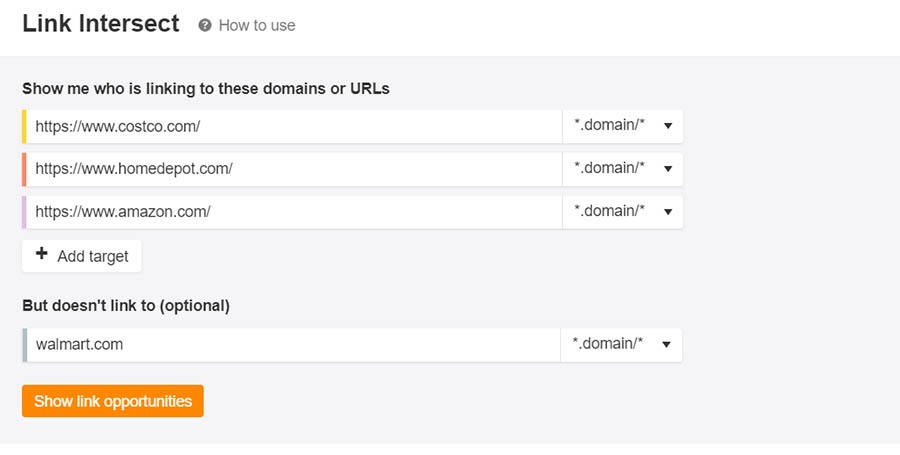
Click Show Link Opportunities. Go and make a cup of coffee. And wait for the magic to happen.
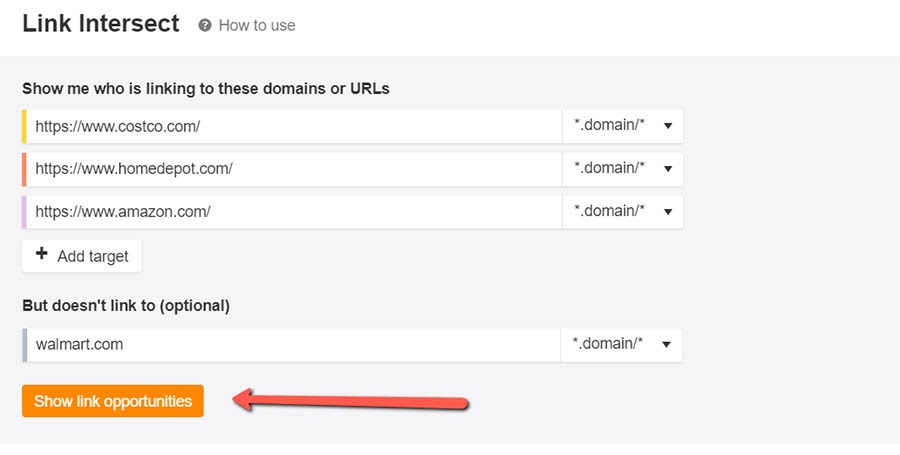
When you return, you’ll find a list of backlinks that your competitors have and you don’t. You can then target some of the strongest sites from the list yourself.
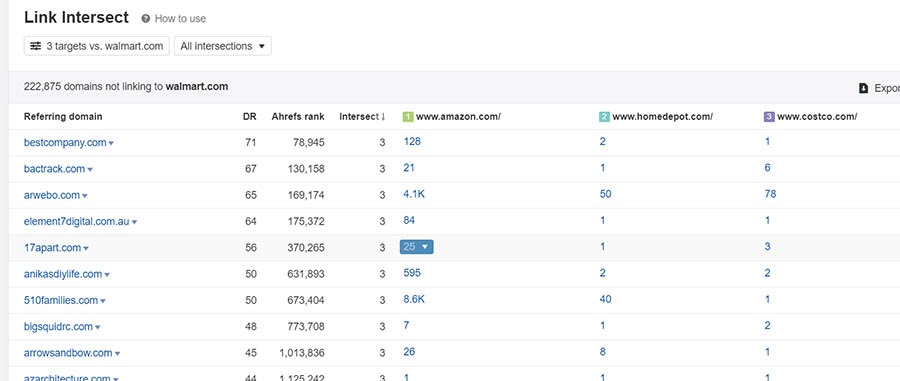
Link Explorer
Founded in 2004 by Rand Fishkin, Moz is arguably one of the best-known SEO tools in the market.
Until a few years ago, their link index was, let’s say, a little underwhelming. That changed when they launched a brand new version of Link Explorer. It blew the old version out of the water and regained Moz its position as a legitimate competitor in the backlink analysis market.

So how do you use it?
From the PRO option in the main navigation, you need to locate the Link Explorer. As with other tools, you then need to put in your website (or a competitors’ site) to grab the data.

You should then see a dashboard that looks like this:
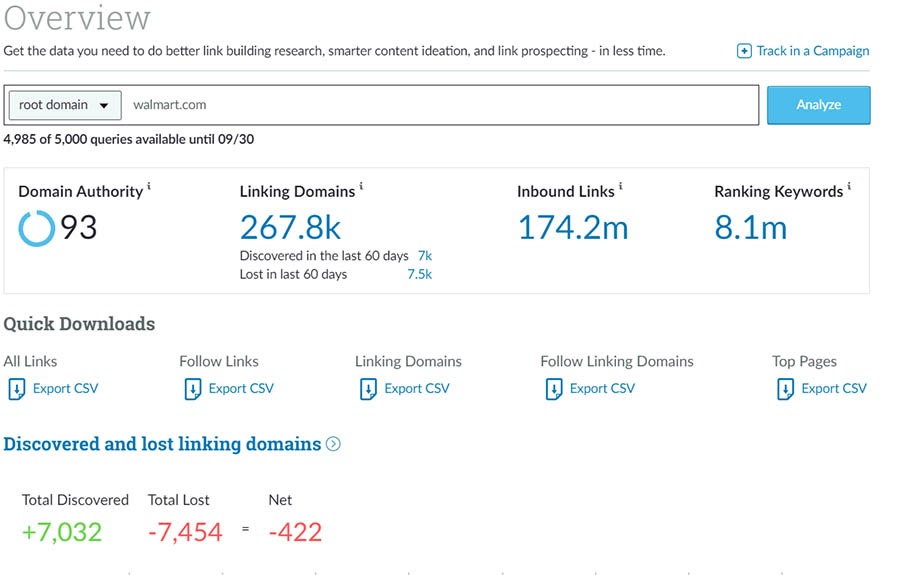
Like with the other tools listed above, you’ll get a wealth of data, including:
- Domain Authority
- Linking domains
- Inbound links
- Ranking keywords
- Discovered and lost linking domains
- Domain authority, page authority, and linking domains over time
- Nofollow and follow over internal and external links
- Top follower links to the site
- Top pages on the site
- Top anchor text for the site
- Linking domains by DA
Moz also has a couple of features that can help you compare your site to your competitors’.
Look on the left-hand side of the navigation and you will see an option called Compare Link Profiles. Click it.
Next, drop your competitors into the boxes provided.
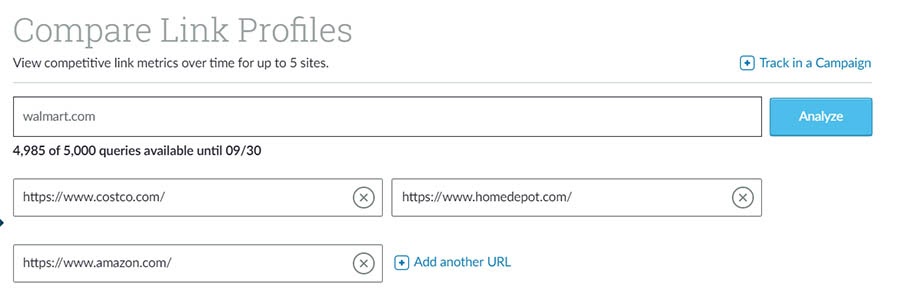
Click Analyze, and grab a twinkie while you wait.
If you’re looking at the root level data you will see:
- Domain Authority
- Spam Score
- Total links
- Internal followed links
- External followed links
- Internal nofollow links
- External nofollow links
- Total linking domains
- Followed linking domains
The results will look a bit like this, and in no way should we be surprised that Amazon has ALL THE LINKS!
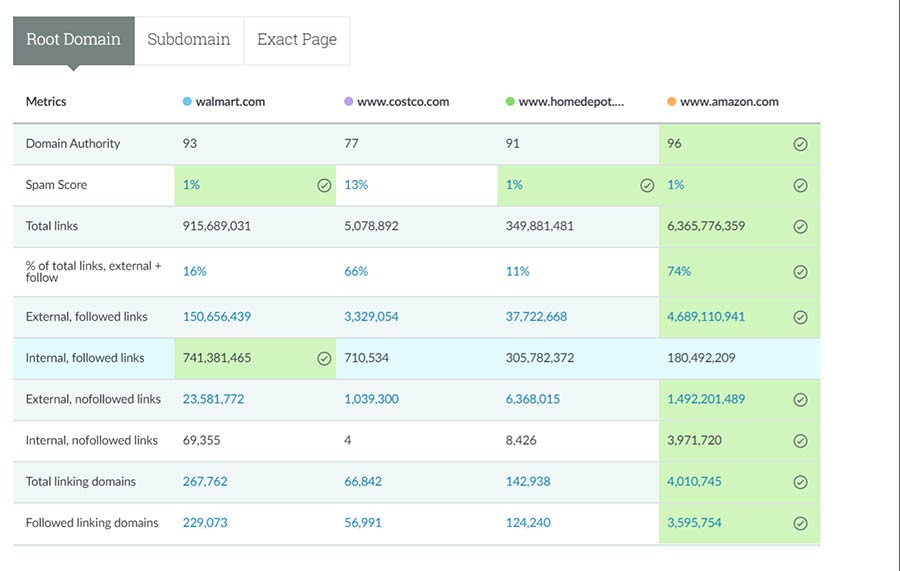
This is also super useful if you’re looking at exact pages on your site and similar pages on a competitor’s site. Links could be the reason your really awesome page doesn’t rank as well as a competitor’s not so awesome page.
You can also compare Domain Authority, Page Authority, and Linking Domains over time.
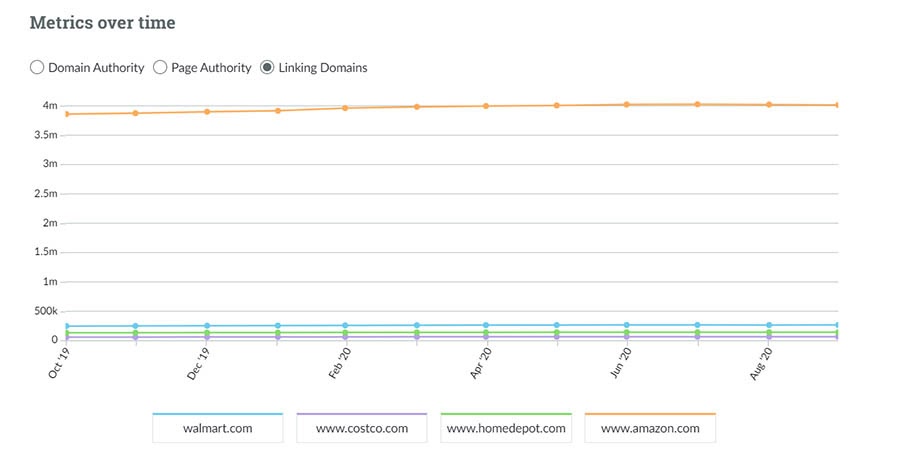
Majestic SEO
Majestic is the grandfather of all backlink tools. It’s probably been around since before the Internet was invented. Heck, they even sent a 3D model of the Internet into space.
Much maligned for its poor UX, Majestic more than makes up for that with its data.
Dropping your URL (or a competitor’s URL) into the search box will give you data on:
- Trust Flow
- Topical Trust Flow
- Link Profile
- Citation Flow
- External backlinks
- Referring domains
- Referring IPs
- Referring subnets
- Link Context
- Crawled and indexed URLs
- Types of backlinks
- Incoming languages and site languages
- Link density of inbound links
- Backlink history
- Anchor text
And so much more.
You also get some (not so pretty) data visualizations.
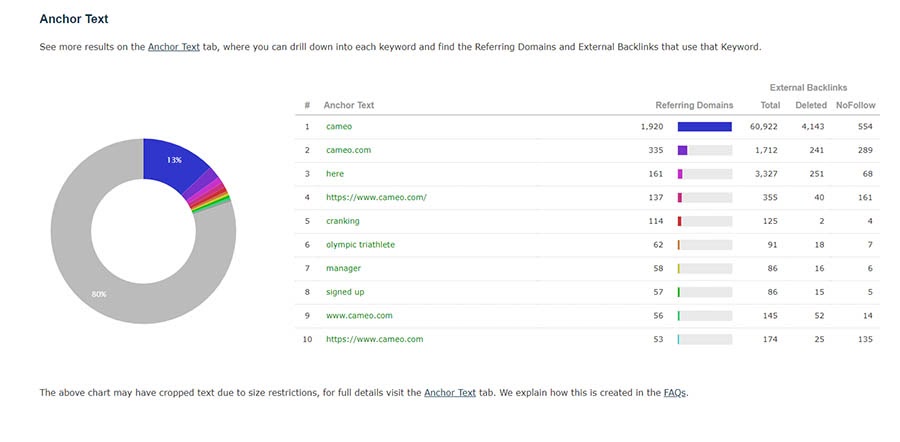
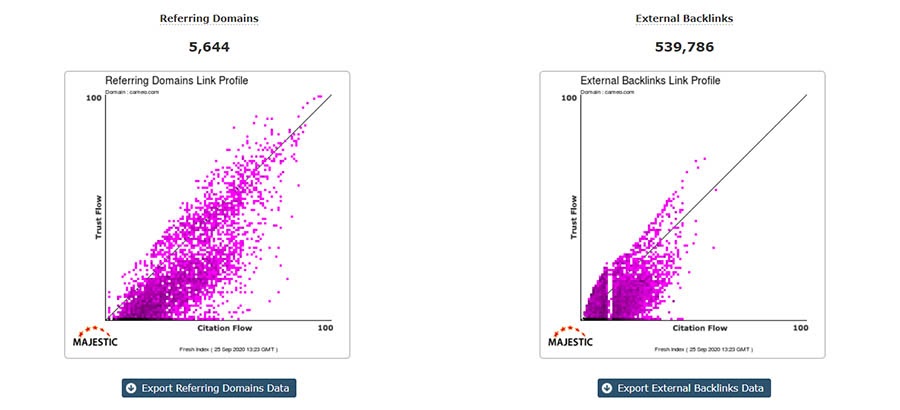
If you want to do a more competitive analysis, then head over to the Related Sites tab and Majestic will give you a breakdown of all the sites it thinks are related to your own. You can then look at who you believe to be your closest competitors and analyze their Link Trust Flow and Citation Flow.
Super useful. And so much data that it will keep you busy for ages.
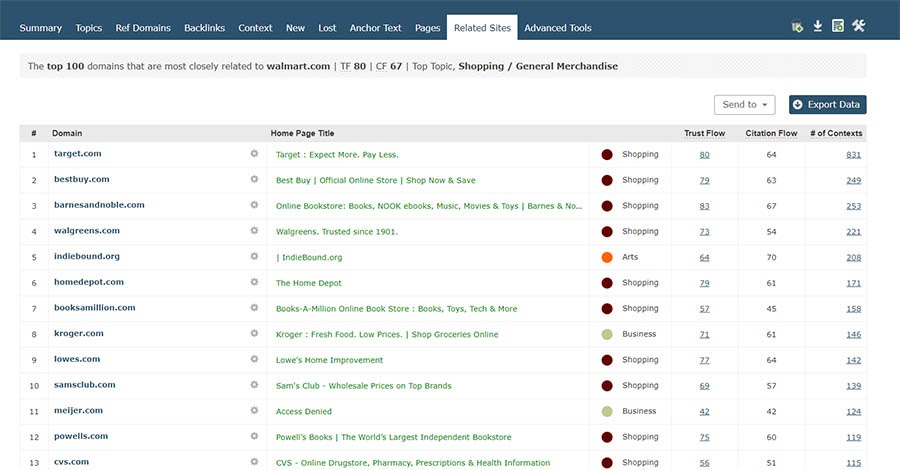
Majestic also has a pretty cool Compare feature (you can compare one site to yours in the Lite version of the tool, and up to five in the Pro version.)
Simply pop your domain into the search box and then click the compare button.

Add a competitor into the second URL box.

Click the search button, and you’ll get backlink comparison data that covers:
- Target type
- Title tag
- Primary Topical Trust Flow
- Trust Flow
- Citation Flow
- Majestic Million (the top million sites in Majestic’s index)
- Referring domains
- Referring IP addresses
- External backlinks
- Indexed URLs
- Average total outlinks per page
That’s a lot of data (which is exportable by the way) for you to dig through. Happy analyzing.
Content
We all know about the importance of great content. Google’s been telling us to create “great content” for years. So how can you spy on your competitor’s content? How can you see what’s working for them and what isn’t? There are many great tools for doing this, but here are two of the most powerful.
BuzzSumo
Buzzsumo was one of the first content analyzing tools to enter the market, launching back in 2012. It has become so ubiquitous in the space that many other tools base theirs around the features and functionality of Buzzsumo. We’re not sure how Buzzsumo feels about this, but imitation is the sincerest form of flattery!
Buzzsumo’s handiest competitor content analysis feature is the Content Web Analyzer. You fill this in the content section of the navigation.
Simply drop in a topic that you and your competitors are likely to cover, and let the tool do its magic.
It will return results like this:
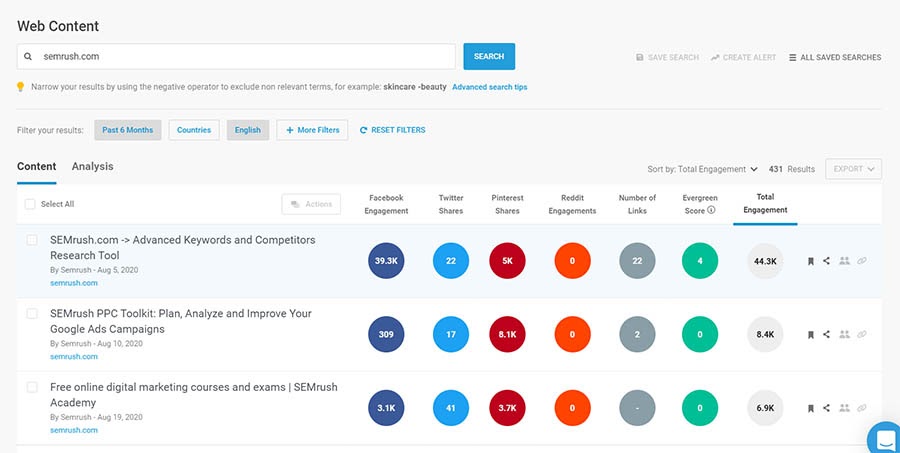
As you can see, it locates the top-performing content for that topic and gives you the following metrics:
- Facebook engagements
- Twitter shares
- Pinterest shares
- Reddit engagements
- Number of links
- Evergreen score
- Total engagement
You can also dig deeper to find out where on the web this type of content is most popular, its word count, and what sort of content gains the most traction for a given topic.
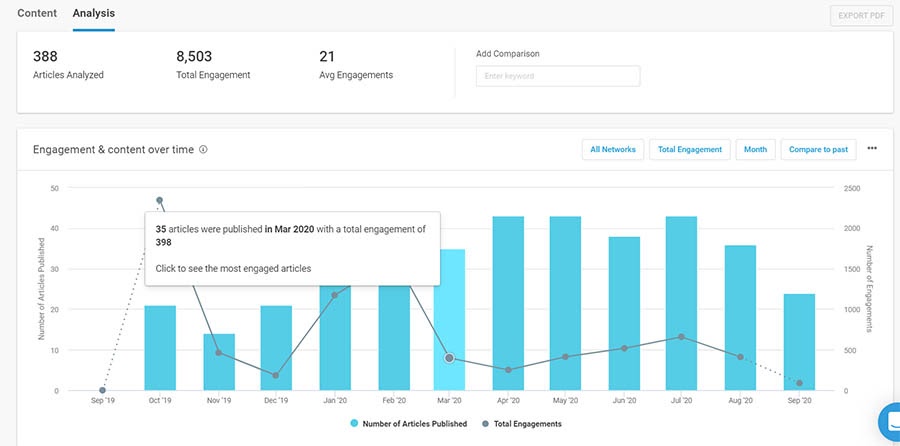
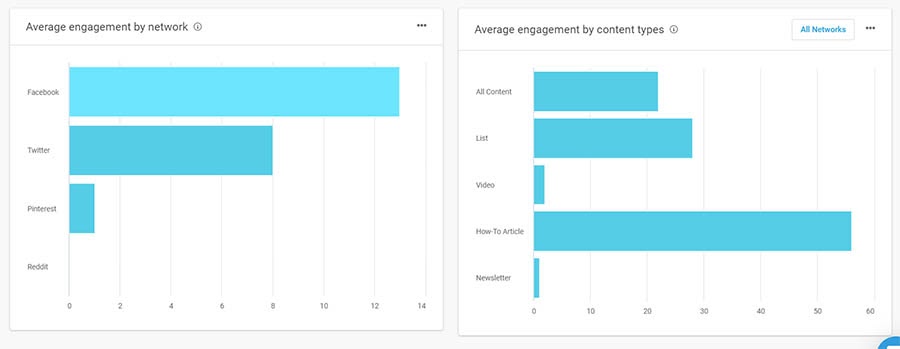
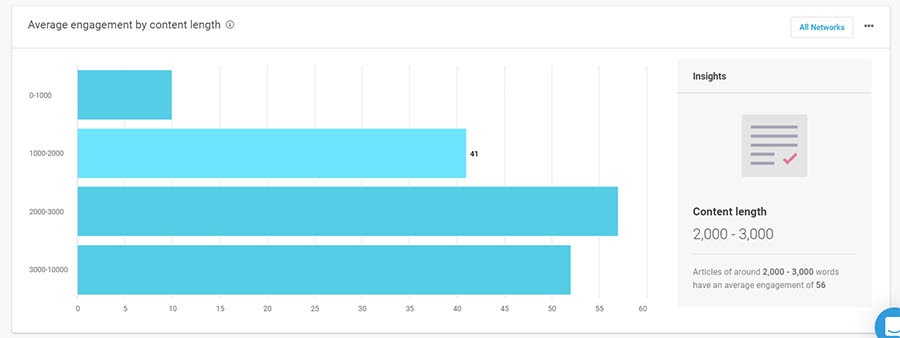
During this, you’ll identify some of your competitors’ most successful content. If you want to learn more about it, Buzzsumo will let you search by domain.
This is extremely useful for uncovering the strategies they’ve used and to what success.
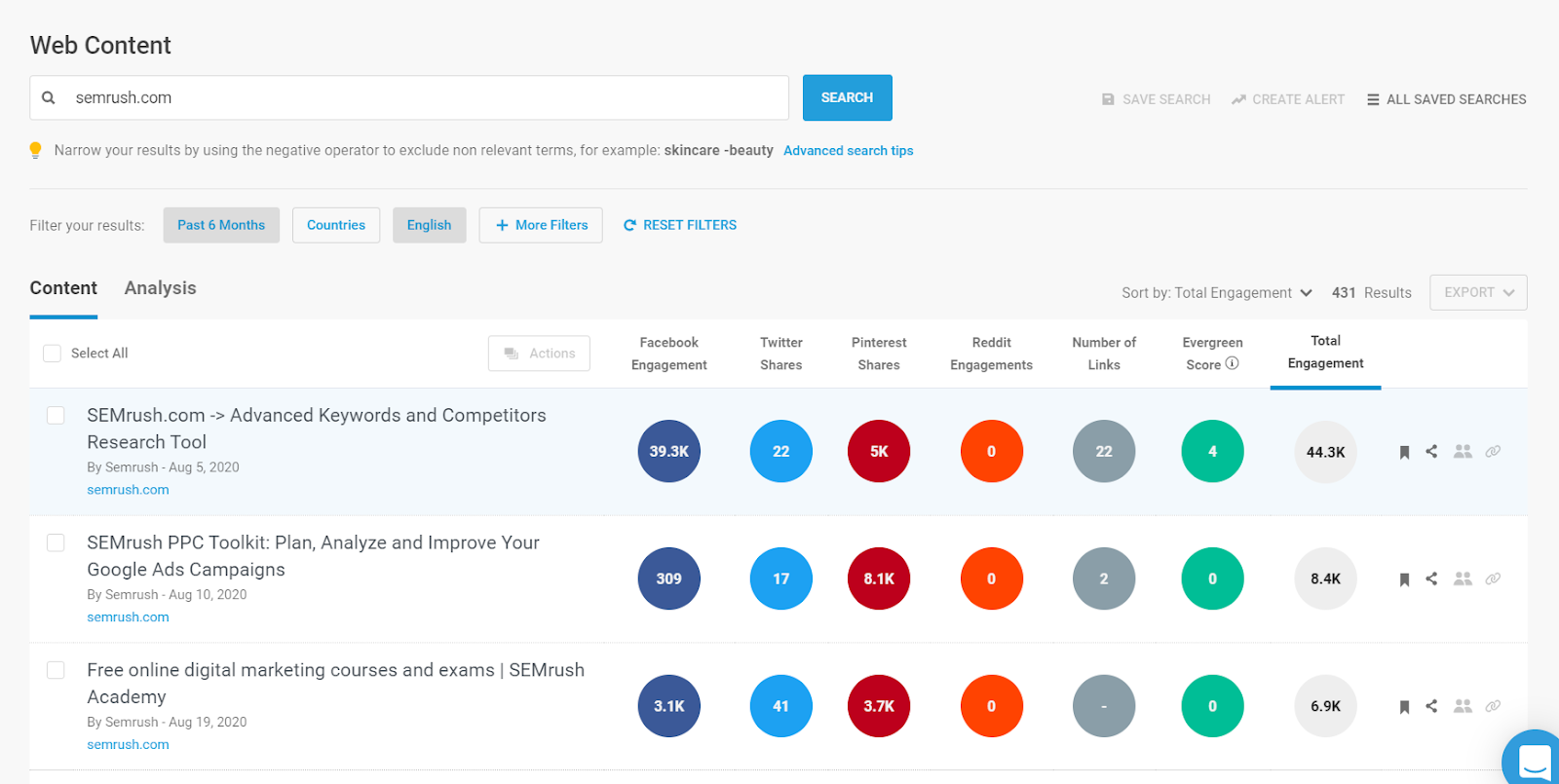
Ahrefs Content Explorer
Ahrefs initially launched as a tool for analyzing websites’ link profiles. Over the years, they’ve added more and more tools to their suite. One of those tools doesn’t get talked about as much — which is a shame because it’s awesome.
Want to try it out?
Log in and head over to the Content Explorer section.
As with Buzzsumo, you just enter the topic you’re looking to analyze and pop it into the box.

You’ll then see a dashboard that brings back loads of data.
- The title of the content
- The author
- Word count
- Twitter shares
- Facebook shares
- Pinterest shares
- Domain rank
- Referring domains
- Organic traffic
- Traffic value
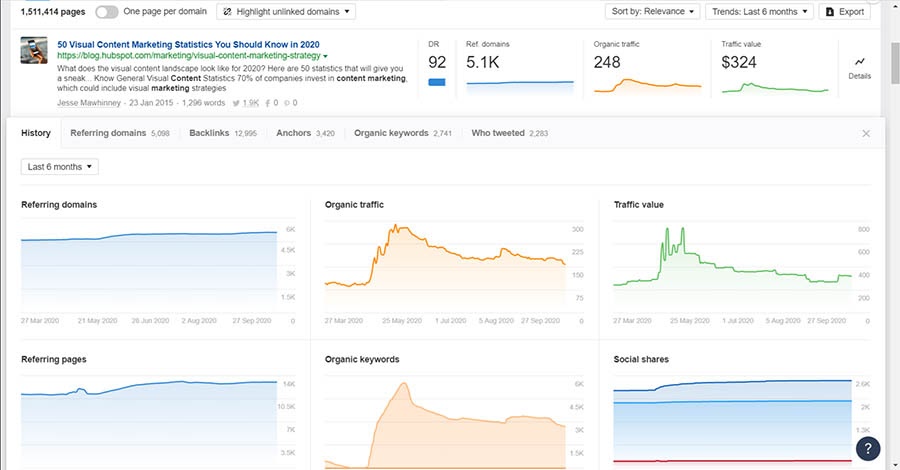
If you’re looking to discover new competitors, then head over to the Websites tab and you’ll see a list of 100 domains with the top-performing content for that topic.
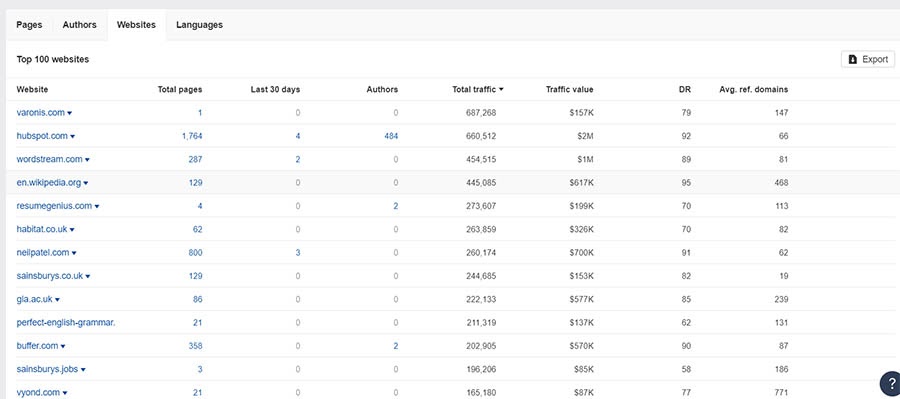
If you know the domain of a competitor, you can also search for their site specifically.
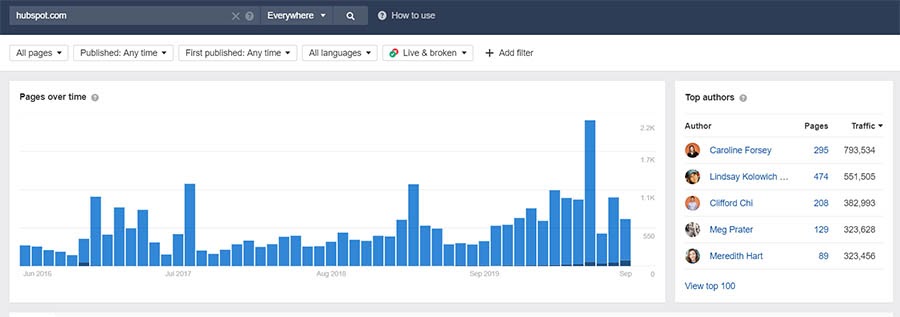
And you’ll get to see their top-performing content.
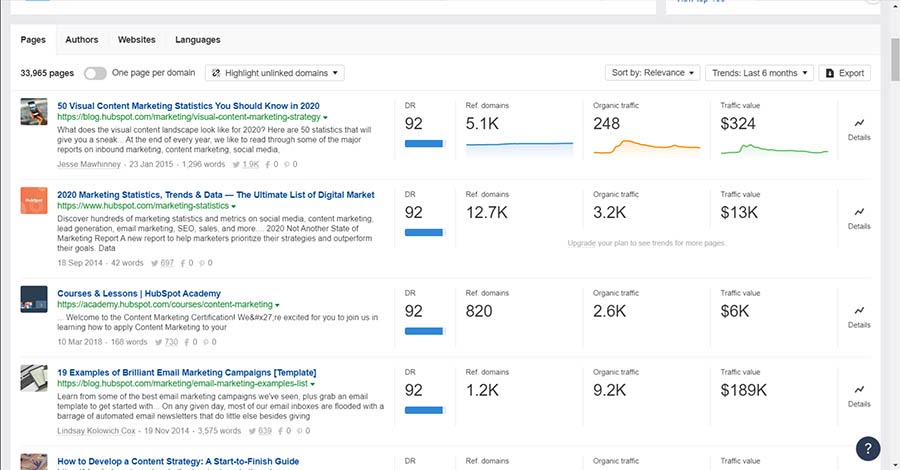
That should keep you busy for some time.
Related: Take Your Content Strategy Up a Level with a Content Audit
Keywords
Solid keyword research is the foundation of any successful SEO campaign — but where’s the best place to find keywords — and more importantly, your competitors’ keywords? Here are some of the most powerful keyword research tools and some of their features.
iSpionage
This is a comprehensive competitor analysis tool that will help you uncover your competitors’ most profitable (paid) keywords, as well as their most successful ad copy and landing pages.
In other words, iSpionage offers deep insights into what’s working best for your competitors in the digital ad space, so you can go one step further and get two steps ahead of them.
Sistrix
Head over to Sistrix’s SEO tab and pop in a keyword that you want to rank for. Sistrix will then search its index and return data, including:
- Competition
- Search volume
- Global search volume
- Similar keywords
- Related keywords
- SERP features
- Top ranking domains
The top-ranking domains will help you surface some of your competitors in the search results.
Semrush
Semrush works in a similar way. Simply dropping your keyword into the search function of the Keyword Explorer section brings back all the metrics you might expect, such as:
- Volume
- Keyword difficulty
- Global volume
- Trends
- Related keywords, variations, and questions
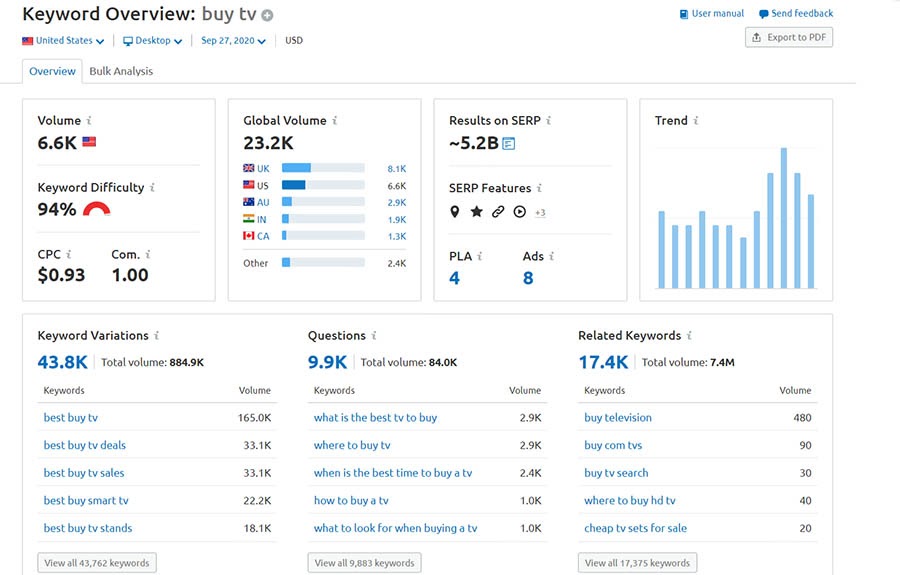
Dig a little further and you’ll see the actual search results for that keyword. You’ll also be able to find competitors to analyze.
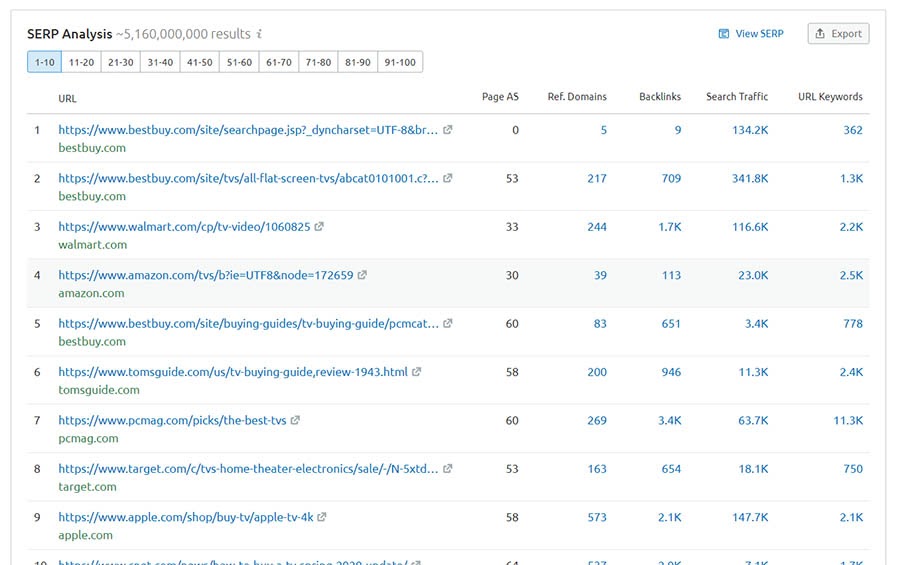
Want to find keywords that your competition ranks for, but you don’t?
Head over to the Keyword Gap tool and pop in your domain and the domains of your competitors.

In only a few seconds, you’ll have data relating to keyword opportunities for your site, as well as an overlap that shows which keywords the domains have in common, and which are unique to each site.
You can even see where your site ranks for a given keyword and where your competitors are outranking you.
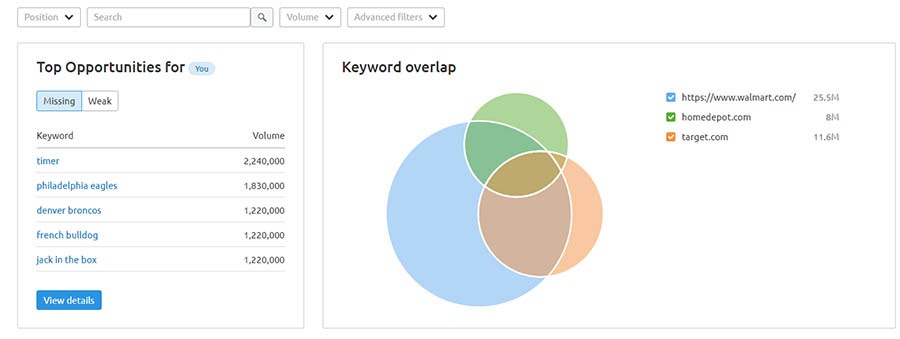
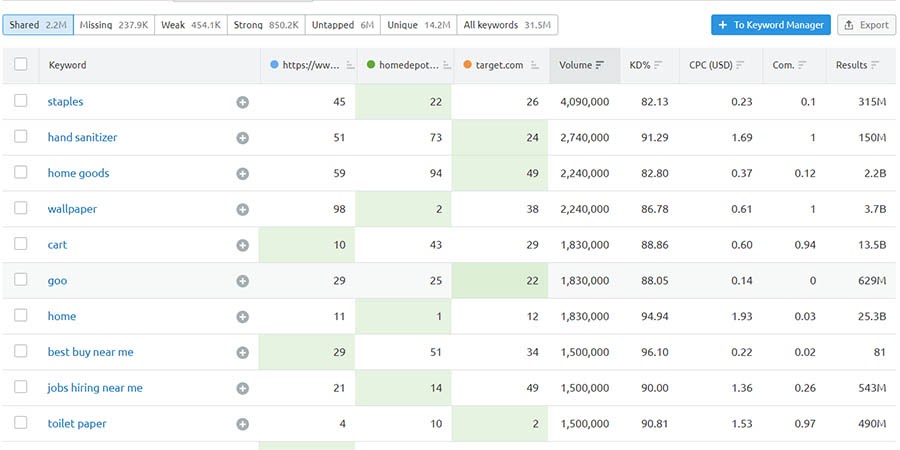
Get Content Delivered Straight to Your Inbox
Subscribe to our blog and receive great content just like this delivered straight to your inbox.
Bonus Tools To Add To Your Arsenal
Unfortunately, no one tool covers everything you need when discovering and analyzing the competition.
With that in mind, here are a few bonus tools to check out too.
- Website Review from WooRank. A free website and SEO checker.
- Ubersuggest. The free version of Ubersuggest brings together metrics that you would see in a site like Semrush.
- Answerthepublic. A free or paid tool that helps you unearth the questions your target market is asking.
- Screaming Frog. A desktop crawler that can help you establish the SEO tactics your competition is using. This tool can also be used to discover broken links on your own site.
- Sitebulb. Another desktop crawler that offers insight into how the competition has set up its website. You can then benchmark, pinpoint, and prioritize your SEO efforts in the areas where your competitors are not doing so well.
- Feedly. A handy tool that enables you to monitor all your competitors’ content in one place.
- Monitorbacklinks. A tool dedicated entirely to monitoring your own and your competitors’ keywords and backlinks.
- Website Grader. Primarily a tool for figuring out how to improve your site, it can also be used to grade your competition.
- Social Mention. A real-time social media and analysis tool that will help you unearth even more of your online competitors.
Another Great Tool? DreamHost SEO Services
Now that you have a bevy of tools to track your competition, it’s time to dive in. Whether you want to monitor ads, backlinks, content, or keywords, you now have your arsenal to get informed and get ahead.
If this is all a little too much to take in and you’d rather leave the nitty-gritty to someone else, why not talk to us about our SEO services? You’ll get your own SEO team, new content every month, regular on-site optimization, and much more — all from just $399 a month.
